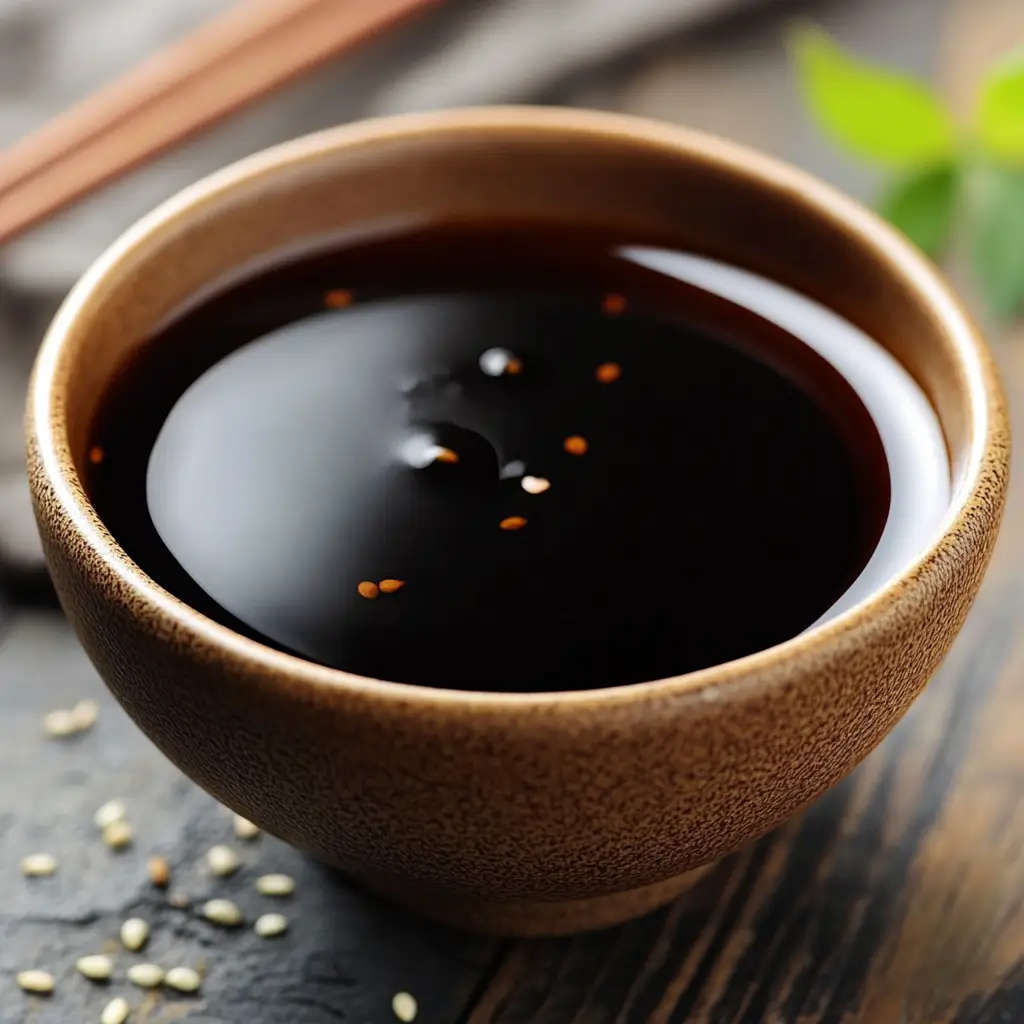Discover the Best Dark Soy Sauce Alternatives
I remember my first time using dark soy sauce. It added a rich flavor to my stir-fry. As I explored Asian cuisine, I found dark soy sauce is key in many kitchens. But finding it can be tough, so I’m sharing the top dark soy sauce substitutes.
Dark soy sauce is thicker, darker, and sweeter than regular soy sauce. It’s great for dishes like soy sauce fried rice. If you can’t find it or want a different taste, there are substitutes like light soy sauce and kecap manis.
Looking into dark soy sauce alternatives, I found many options. Each has its own taste and use. From oyster sauce to coconut aminos, there’s something for everyone. We’ll look at the best dark soy sauce substitutes and soy sauce alternatives for your cooking.
Table of Contents
What is Dark Soy Sauce?
Exploring dark soy sauce is exciting. It’s a key part of Asian cooking, made from fermented soybeans, grains, salt, and molds. This condiment has been around for centuries. Its flavor and color come from fermentation, which sweetens it and adds umami.
Looking for a dark soy sauce substitute can be tough. But knowing what dark soy sauce is helps. It’s used to enhance color in dishes and adds a sweet-salty taste to marinades, stir-fries, and braising liquids.
Common Uses in Cooking
Dark soy sauce is versatile in cooking. It’s great in marinades, stir-fries, braising liquids, and dipping sauces. Its sweet-salty taste and dark color add depth to dishes. Knowing its uses helps find a good substitute when cooking without it.
Dark soy sauce is often used to glaze meat like pork or beef. It also flavors vegetables. It’s a key ingredient in many Asian sauces, like teriyaki and stir-fry sauces. Its rich flavor and dark color make it essential in Asian cooking.
Why Look for Alternatives?
Exploring soy sauce alternatives is important for many reasons. Some people have dietary restrictions or allergies that make dark soy sauce hard to use. For example, those with gluten intolerance or soy allergies face challenges.
Others might dislike the strong taste of dark soy sauce. Or they might want something with less salt. Looking into soy sauce alternative options can help. This way, we can find the right choice for our cooking needs.
Dietary Restrictions and Allergies
Studies show that soy or wheat allergies limit the use of traditional soy sauce. This creates a need for soy-free alternatives. Also, more people are cutting down on sodium for health reasons. This leads them to seek out low-sodium soy sauce alternatives.
Flavor Preferences and Versatility
Some people prefer lighter or sweeter flavors. For them, tamari or coconut aminos are great choices. Tamari is gluten-free and has a richer, less salty taste.
Coconut aminos, made from coconut sap and sea salt, is soy-free and gluten-free. It has a slightly sweeter taste than light soy sauce.
Thinking about these factors helps us choose the best soy sauce alternative. Whether it’s for dietary reasons, allergies, or taste, there are many options. These can make our cooking better and more enjoyable.
| Alternative | Description |
|---|---|
| Tamari | Gluten-free, made from soybeans, richer and less salty |
| Coconut Aminos | Soy-free and gluten-free, derived from coconut sap and sea salt, slightly sweeter |
| Liquid Aminos | Concentrated liquid protein from soybeans, similar flavor to light soy sauce, lower sodium content |
Best Dark Soy Sauce Alternatives
Looking for a dark soy sauce substitute? There are many options. You can mix light soy sauce with brown sugar for a simple swap. This combo works as a 1:1 substitute in most recipes. Tamari, a Japanese soy sauce byproduct, is another choice. It’s often gluten-free and tastes similar to dark soy sauce.
If you like things sweeter, Kecap Manis or sweet soy sauce is a good pick. This Indonesian soy sauce is thick and sweet, perfect for dishes needing a bit of sweetness. Coconut aminos is another option. It has a salty taste with a hint of sweetness, and you can use it 1:1.
Other dark soy sauce substitutes include:
- Mushroom soy sauce, which has a rich umami flavor and can be used in equal amounts as a replacement
- Hoisin sauce, which can be used as a 1:1 substitute but may require adjustments to other sweeteners
- Oyster sauce, which has a savory and slightly sweet taste and is a great option for stir-fries
When picking a dark soy sauce substitute, think about the dish’s flavor and ingredients. Try different options to find the best one for your taste and dietary needs.
Using Tamari as a Substitute
Tamari is a Japanese soy sauce known for its rich, savory taste. It’s often seen as a best dark soy sauce substitute. Being gluten-free, it’s great for those with dietary restrictions.
Using tamari as a dark soy sauce alternative is smart. It’s less salty than regular soy sauce. This makes it perfect for recipes needing deep flavor without too much salt.
Flavor Profile and Benefits
Tamari tastes similar to dark soy sauce, with a rich, savory flavor. It’s gluten-free and less salty. These traits make it versatile for many dishes.
Cooking Tips for Tamari
When cooking with tamari, start with small amounts. It’s strong and can overpower other flavors. Use it in stir-fries, marinades, and mix it with other ingredients for unique tastes.
| Ingredient | Ratio | Description |
|---|---|---|
| Tamari | 1:1 | Use as a direct substitute for dark soy sauce |
| Soy sauce and molasses | 3:1 | Mix with molasses to replicate the color and flavor of dark soy sauce |
Exploring Coconut Aminos
I’m excited to share what I’ve learned about coconut aminos. It’s a great choice for those who want to avoid dark soy sauce. Made from fermented coconut sap and salt, it’s low in sodium and rich in amino acids.
Coconut aminos has about 90 mg of sodium per teaspoon. That’s much less than regular soy sauce. It’s perfect for those watching their sodium intake. Plus, you can use it just like soy sauce in recipes.
Nutritional Benefits
Coconut aminos is not just a soy sauce substitute. It’s also packed with amino acids, which help build and repair body tissues. It’s also good for diets like Whole30, Paleo, and Keto.
Recommended Recipes
Coconut aminos can be used in many ways. Here are some ideas to get you started:
- Stir-fries: Swap soy sauce with coconut aminos in your stir-fry recipes.
- Marinades: Mix it with other ingredients for tasty marinades.
- Sauces: Use it as a base for homemade sauces like teriyaki or BBQ.
Adding coconut aminos to your cooking can be a game-changer. It’s a low-sodium, nutritious alternative to soy sauce. It’s perfect for those who care about their health.
The Role of Worcestershire Sauce
Worcestershire sauce is a great dark soy sauce substitute. It has a sweet and savory taste. This makes it perfect for marinades or stir-fry sauces.
It’s a versatile ingredient that can add depth to any meal. This is why it’s a good choice when you don’t have dark soy sauce.
Worcestershire sauce brings a rich, umami flavor to dishes. This is great for recipes that need a sweet and savory taste. It works well in many dishes, from steak pies to salads.
Here are some popular ways to use Worcestershire sauce as a substitute:
- Soy Sauce: 15ml of Worcestershire sauce can be replaced with 15ml of soy sauce
- Balsamic Vinegar: 15ml of Worcestershire sauce can be substituted with 15ml of balsamic vinegar
- Miso Paste: 15ml of Worcestershire sauce can be replaced with 15ml of miso paste and a splash of water

Using Worcestershire sauce in your cooking can open up new flavor possibilities. It’s a great dark soy sauce substitute. It can make your dishes more flavorful without dark soy sauce.
| Ingredient | Replacement Ratio |
|---|---|
| Soy Sauce | 1:1 |
| Balsamic Vinegar | 1:1 |
| Miso Paste | 1:1 with a splash of water |
Miso Paste: A Unique Choice
Exploring soy sauce alternatives, I found miso paste. It’s a fermented soybean paste from Japanese cuisine. It brings a unique umami flavor that can make any dish better. Miso paste is great for those who need a gluten-free and soy-free option.
Miso paste is very versatile. There are over 1,000 types, so you can pick the right one for your recipe. In the US, white and dark miso are common. White miso is mild, while dark miso is stronger. Use 1 ½ teaspoons of soy sauce for every tablespoon of miso to substitute.
Some popular substitution ratios for miso paste include:
- 1:1 ratio with tamari or coconut aminos
- 1:2 ratio with soy sauce
- 1:4 ratio with fish sauce
When using miso paste, think about the flavor and texture you want. It adds a rich, savory taste to soups, sauces, and marinades. If you’re looking for a dark soy sauce substitute, miso paste is a good choice.
| Miso Type | Flavor Profile | Substitution Ratio |
|---|---|---|
| White Miso | Mild, sweet | 1:1 with tamari or coconut aminos |
| Dark Miso | Strong, savory | 1:2 with soy sauce |
In conclusion, miso paste is a unique and versatile soy sauce alternative. It can add depth and richness to your dishes. With its many types and substitution ratios, you can experiment with different flavors and textures to find the perfect combination for your recipes.
Using Liquid Aminos
Liquid aminos is a great dark soy sauce substitute. It’s made from soybeans and water, with less sodium than soy sauce. This makes it perfect for those who want to cook without dark soy sauce.
Liquid aminos is versatile in many dishes. You can use it just like soy sauce, 1-to-1 ratio. It’s great for stir-fries, marinades, or sauces, adding a savory flavor to your meals.
Difference Between Liquid Aminos and Soy Sauce
Liquid aminos and soy sauce are similar but different. Liquid aminos taste sweeter and nuttier, which can make your dishes taste better. It also has less sodium, which is good for those watching their salt intake.
Incorporating into Various Dishes
To use liquid aminos well, you need to know how to add it to your cooking. Here are some tips:
- Use liquid aminos as a marinade for meats, poultry, or seafood to add depth and flavor.
- Add liquid aminos to your stir-fries and sautés for a burst of umami flavor.
- Mix liquid aminos with other ingredients to create a sauce or seasoning for your dishes.

By following these tips and using liquid aminos, you can make tasty meals. It’s low in sodium and versatile, making it a great addition to your kitchen.
| Soy Sauce Alternative | Sodium Content (per teaspoon) |
|---|---|
| Liquid Aminos | 310 mg |
| Regular Soy Sauce | 291 mg |
| Lower-Sodium Soy Sauce | 142 mg |
| Coconut Aminos | 130 mg |
Nutritional Yeast: An Unorthodox Alternative
Nutritional yeast is a favorite among vegans. It tastes nutty and cheesy, with a deep umami flavor. If you’re looking for a soy sauce alternative, try nutritional yeast.
This ingredient is packed with protein, fiber, and B vitamins. It has beta-glucan, a fiber that boosts your immune system. It also helps with digestion and prevents constipation.
| Benefit | Description |
|---|---|
| High in protein | Contains all nine essential amino acids |
| Rich in fiber | Can help improve digestion and prevent constipation |
| Good source of B vitamins | Important for energy production and metabolic processes |
Nutritional yeast is great for many dishes. Use it in soups, sauces, pasta, and salads. It’s a soy sauce alternative that’s both gluten-free and soy-free.
Tips for Adjusting Recipes with Substitutes
When you’re cooking without dark soy sauce, it’s key to adjust the recipe to get the right flavors. You might need to add more or less of the substitute, and tweak other ingredients too. It’s important to balance the flavors with acidity, sweetness, and umami to get the taste just right.
First, think about what dark soy sauce does in your recipe. Is it for color, sweetness, or umami? Knowing this helps pick the right substitute. For example, if you want umami, try miso paste or tamari.
Balancing Flavors in Your Meals
To substitute dark soy sauce, balance your meal’s flavors. Add ingredients for acidity, sweetness, or umami. Here are some ideas:
- Lemon juice or vinegar for acidity
- Honey or sugar for sweetness
- Miso paste or tamari for umami
Experimenting with Different Combinations
Try different ingredients to find the perfect flavor. Don’t hesitate to experiment with new flavors. Some good substitutes are coconut aminos, Worcestershire sauce, and balsamic vinegar. Mix them with other flavors to make your dish unique and tasty.
Conclusion: Finding Your Perfect Soy Sauce Alternative
There are many dark soy sauce substitutes out there. They cater to different diets and tastes. Options like tamari and miso paste add depth and complexity to your dishes.
My advice is to get creative in the kitchen. Try each substitute alone and then in your favorite recipes. You might be amazed at how a small change can make a big difference. With some experimentation, you’ll find the perfect soy sauce alternative to take your cooking to the next level.







